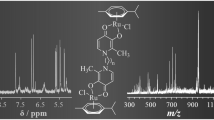Abstract
The present model study explores the chemistry of methionine complexes and ternary methionine-guanine adducts formed by trans-[PtCl2(NH3)2] (1) and antitumor trans-[PtCl2(NH3)quinoline] (2) using 1D (1H, 195Pt) and 2D NMR spectroscopy. Compound 2 was substitution inert in reactions with N-acetyl-lmethionine [AcMet(H)]. Reactions of trans-[PtCl(NO3)(NH3)quinoline] (5) ("monoactivated" 2) with AcMetH in water and acetone at various stoichiometries point to Pt(II)-S binding that requires prior activation of the Pt-Cl bond by labile oxygen donors. Trans-[PtCl{AcMet(H)-S}(NH3)quinoline](NO3) (6) and trans-[Pt{AcMet(H)-S}2(NH3)quinoline](NO3)2 (7) were isolated from these mixtures. At high [Cl–], AcMet(H) is displaced from 7, giving 6. Frozen stereodynamics in 6 at the thioether-S and slow rotation about the Pt-Nquinoline bond result in four spectroscopically distinguishable diastereomers. 1H NMR spectra of 7 show faster exchange dynamics due to mutual trans-labilization of the sulfur donors. Substitution of chloride in trans-[PtCl(9-EtGua)(NH3)L]NO3 (L=NH3, 3; L=quinoline, 4; 9-EtGua=9-ethylguanine, which mimics the first DNA binding step of 1 and 2) by methionine-sulfur proceeded ca. 2.5 times slower for the quinoline compound. Both reactions, in turn, proved to be ca. 4 times faster than binding of a second nucleobase under analogous conditions. From the resulting mixtures the ternary adducts trans-[Pt(AcMet-S)(9-EtGua-N7)(NH3)L](NO3, Cl) (L=NH3, 8; L=quinoline, 9) were isolated. A species analogous to 9 formed in a rapid reaction between 6 and 5′-guanosine monophosphate (5′-GMP). From NMR data an AMBER-based solution structure of the resulting adduct, trans-[Pt(AcMet-S)(5′-GMP-N7)(NH3)quinoline] (10), was derived. The unusual reactivity along the N7-Pt-S axis in 8–10 resulted in partial release of both 9-EtGua and AcMet at high [Cl–]. Possible consequences of the kinetic and structural effects (e.g., trans effect of sulfur, steric demand of quinoline) observed in these systems with respect to the (trans)formation of potential biological cross-links are discussed.
Similar content being viewed by others
Author information
Authors and Affiliations
Additional information
Received: 25 May 1998 / Accepted: 6 August 1998
Rights and permissions
About this article
Cite this article
Bierbach, U., Farrell, N. Structural and reactivity studies on the ternary system guanine/methionine/trans-[PtCl2(NH3)L] (L=NH3, quinoline): implications for the mechanism of action of nonclassical trans-platinum antitumor complexes. JBIC 3, 570–580 (1998). https://doi.org/10.1007/s007750050270
Issue Date:
DOI: https://doi.org/10.1007/s007750050270




